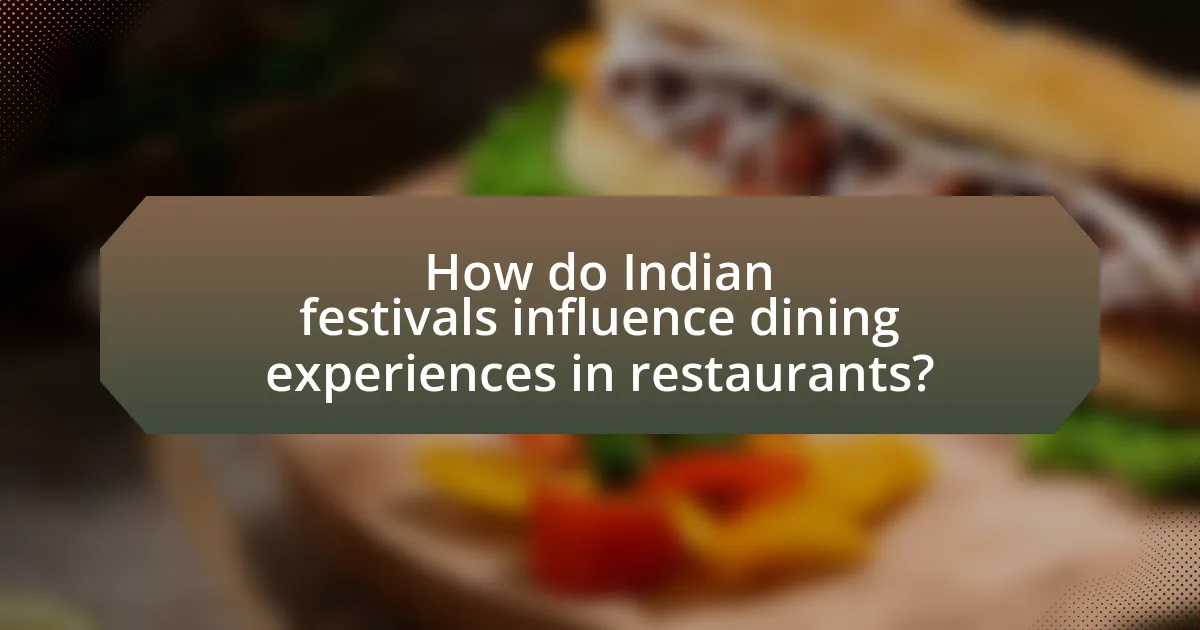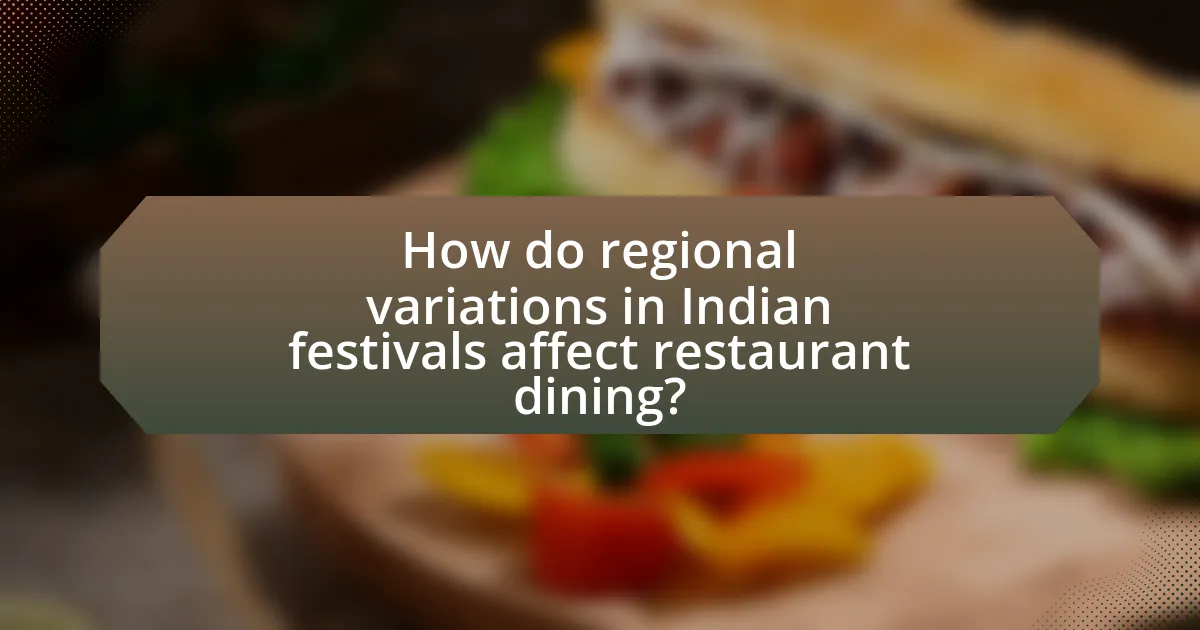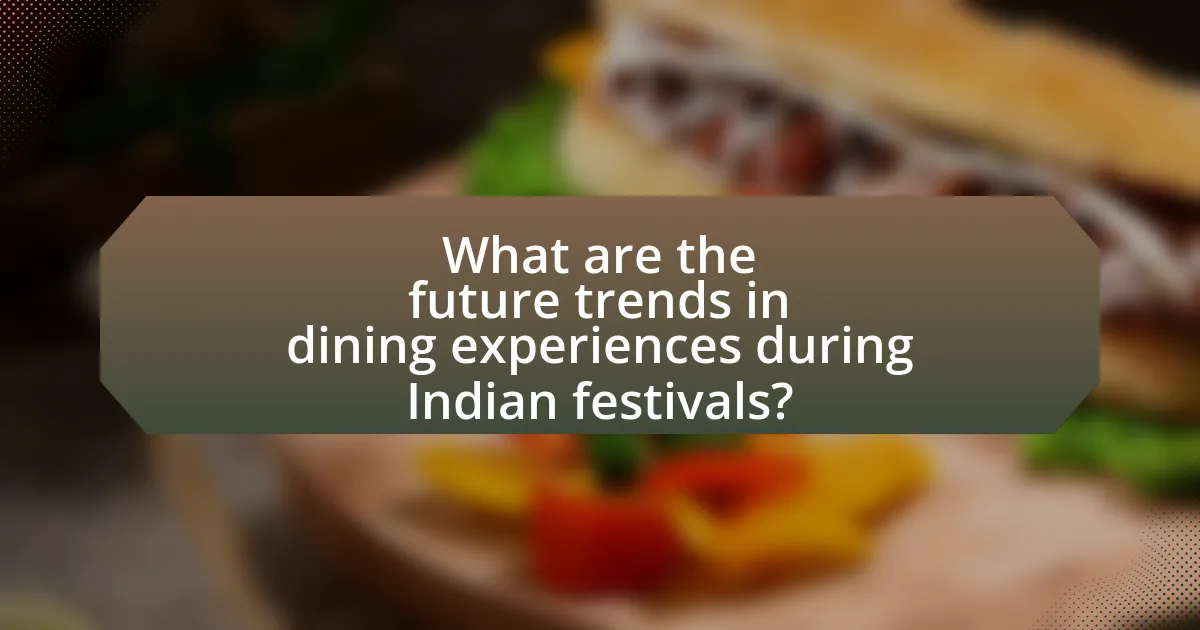The article examines how Indian festivals significantly shape dining experiences in restaurants by influencing menu offerings, decorations, and special events. It highlights the economic impact of festivals, noting a potential 30% increase in restaurant patronage during celebrations like Diwali and Eid. The piece discusses the role of cultural practices in enhancing dining atmospheres, the incorporation of regional cuisines, and the use of technology and sustainability in festival dining. Additionally, it explores community involvement and local customs that enrich restaurant offerings during these festive occasions.

How do Indian festivals influence dining experiences in restaurants?
Indian festivals significantly influence dining experiences in restaurants by introducing special menus, themed decorations, and unique cultural events. During festivals like Diwali and Eid, restaurants often create festive menus featuring traditional dishes that reflect the culinary heritage associated with these celebrations, such as sweets for Diwali or biryani for Eid. Additionally, restaurants enhance the dining atmosphere with decorations that resonate with the festival’s spirit, such as lights and rangoli for Diwali, which attract customers seeking an immersive experience. Furthermore, many establishments host events like live music or dance performances that celebrate the cultural significance of the festival, thereby enriching the overall dining experience. This alignment with cultural practices not only boosts customer engagement but also increases footfall during festive seasons, as evidenced by a 30% rise in restaurant patronage reported during major Indian festivals.
What role do traditional Indian festivals play in restaurant dining?
Traditional Indian festivals significantly enhance restaurant dining by driving increased foot traffic and encouraging special menu offerings. During festivals like Diwali and Eid, restaurants often create themed decorations and offer traditional dishes that resonate with cultural significance, attracting customers seeking authentic experiences. For instance, a study by the National Restaurant Association of India indicates that restaurant sales can increase by up to 30% during major festivals, highlighting the economic impact of these celebrations on dining establishments. Additionally, festivals foster a sense of community, as families and friends gather to celebrate, often choosing restaurants as venues for their gatherings, further solidifying the role of traditional festivals in shaping dining experiences.
How do festivals affect menu offerings in restaurants?
Festivals significantly influence menu offerings in restaurants by prompting the introduction of special dishes that reflect cultural traditions and seasonal ingredients. During Indian festivals, such as Diwali or Holi, restaurants often create themed menus featuring traditional foods like sweets, snacks, and regional specialties that resonate with the festive spirit. This adaptation not only attracts customers seeking authentic experiences but also enhances the restaurant’s appeal by showcasing culinary diversity. For instance, a study by the National Restaurant Association highlights that 70% of consumers are more likely to dine out during holidays when unique menu items are available, demonstrating the direct correlation between festivals and increased restaurant patronage.
What types of special events do restaurants host during festivals?
Restaurants host a variety of special events during festivals, including themed dinners, food tastings, live music performances, and cultural showcases. These events are designed to enhance the dining experience by incorporating traditional dishes, festive decorations, and entertainment that reflect the spirit of the festival. For example, during Diwali, many restaurants offer special menus featuring traditional sweets and savory dishes, while hosting events that include dance performances or music to celebrate the occasion. Such initiatives not only attract customers but also create a vibrant atmosphere that aligns with the cultural significance of the festival.
How do cultural practices during festivals shape dining atmospheres?
Cultural practices during festivals significantly shape dining atmospheres by creating a sense of community and enhancing the sensory experience of meals. During Indian festivals, such as Diwali or Holi, traditional foods are often prepared and shared, fostering communal dining and celebration. This practice not only emphasizes the importance of food in cultural identity but also transforms restaurants into vibrant spaces filled with decorations, music, and themed menus that reflect the festive spirit. For instance, during Diwali, restaurants may feature special lighting and serve traditional sweets, which enhances the overall dining experience and attracts customers seeking to partake in the celebration.
What decorations and themes are commonly used in restaurants during festivals?
Restaurants commonly use vibrant colors, traditional motifs, and thematic decorations during festivals. For instance, during Diwali, restaurants often adorn their spaces with diyas (oil lamps), colorful rangoli designs, and strings of lights to create a festive atmosphere. Similarly, during Holi, establishments may incorporate bright powders, floral decorations, and playful elements to reflect the spirit of the celebration. These decorations not only enhance the dining experience but also resonate with cultural significance, as they reflect the traditions and values associated with each festival.
How do music and entertainment contribute to the dining experience during festivals?
Music and entertainment significantly enhance the dining experience during festivals by creating an engaging atmosphere that encourages social interaction and enjoyment. The presence of live music or performances can elevate the mood, making meals more memorable and enjoyable. For instance, studies show that restaurants featuring live music can increase customer satisfaction and prolong dining duration, leading to higher sales. Additionally, cultural performances during Indian festivals, such as traditional dance or music, can immerse diners in the festive spirit, fostering a sense of community and celebration. This combination of auditory and visual stimulation not only enriches the dining experience but also aligns with the cultural significance of the festival, making the meal an integral part of the celebration.
What are the economic impacts of festivals on restaurant businesses?
Festivals significantly boost restaurant businesses by increasing customer footfall and sales. During festivals, restaurants often experience a surge in demand due to celebratory dining, leading to higher revenue. For instance, a study by the National Restaurant Association found that 75% of consumers are more likely to dine out during holidays and festivals, resulting in a notable increase in average daily sales. Additionally, restaurants may introduce special menus or promotions tailored to festival themes, further attracting customers and enhancing profitability. This economic impact is evident in cities with vibrant festival cultures, where local eateries report up to a 30% increase in sales during peak festival periods.
How do festivals drive customer traffic to restaurants?
Festivals drive customer traffic to restaurants by creating a heightened sense of community and celebration, which attracts diners seeking unique culinary experiences. During festivals, restaurants often offer special menus, themed decorations, and events that resonate with the festive spirit, encouraging both locals and tourists to dine out. For instance, during Diwali, many restaurants in India introduce traditional sweets and festive dishes, leading to increased footfall. According to a study by the National Restaurant Association of India, festivals can boost restaurant sales by up to 30% as families and friends gather to celebrate, thus significantly enhancing customer traffic.
What financial benefits do restaurants gain from festival promotions?
Restaurants gain increased revenue from festival promotions through heightened customer traffic and enhanced visibility. During festivals, restaurants often experience a surge in patrons seeking celebratory dining experiences, leading to higher sales volumes. For instance, a study by the National Restaurant Association indicated that restaurants can see a 20-30% increase in sales during major festivals compared to regular days. Additionally, festival promotions can attract new customers who may return for future visits, further boosting long-term profitability.

How do regional variations in Indian festivals affect restaurant dining?
Regional variations in Indian festivals significantly influence restaurant dining by altering menu offerings, customer preferences, and dining experiences. For instance, during Diwali in North India, restaurants often feature special sweets and festive thalis, while in South India, Onam celebrations include elaborate feasts known as Onam Sadhya, which are served on banana leaves. These regional specialties cater to local tastes and traditions, driving increased footfall and sales during festival seasons. Additionally, restaurants may adapt their ambiance and marketing strategies to reflect the cultural significance of these festivals, enhancing the overall dining experience and attracting diverse clientele.
What are the key differences in festival celebrations across Indian regions?
Festival celebrations across Indian regions differ significantly in terms of customs, rituals, and the foods associated with them. For example, Diwali, celebrated nationwide, features distinct regional variations: in North India, it emphasizes lighting diyas and bursting firecrackers, while in South India, it focuses on family gatherings and special meals like sweets and savory snacks. In West Bengal, Durga Puja is marked by elaborate idol processions and traditional Bengali dishes, whereas in Gujarat, Navratri is celebrated with garba dances and fasting, leading to specific vegetarian dishes. These regional differences reflect local cultures, traditions, and agricultural practices, influencing the dining experiences in restaurants during these festivals, as they often tailor their menus to include traditional dishes specific to the celebrations of that region.
How do regional cuisines influence restaurant menus during festivals?
Regional cuisines significantly influence restaurant menus during festivals by incorporating traditional dishes and ingredients that reflect local customs and celebrations. For instance, during Diwali, many Indian restaurants feature sweets like gulab jamun and savory snacks such as samosas, which are integral to the festival’s culinary traditions. This alignment with regional cuisines not only attracts customers seeking authentic festive experiences but also enhances the cultural relevance of the dining options available. Additionally, restaurants may adapt their menus to highlight seasonal ingredients that are traditionally used in festival preparations, further reinforcing the connection between regional cuisine and festive dining.
What unique dining experiences are offered in different states during festivals?
During Indian festivals, unique dining experiences vary significantly across states, reflecting local traditions and culinary practices. For example, in Punjab during Baisakhi, restaurants often serve traditional dishes like Sarson da Saag and Makki di Roti, accompanied by live folk music, creating an immersive cultural atmosphere. In West Bengal, the Durga Puja festival features elaborate buffet spreads in restaurants, showcasing dishes like Bhog, which includes Khichuri and Labra, served in a communal setting to promote sharing and togetherness. In Gujarat, during Navratri, eateries offer special thalis that include a variety of vegetarian dishes, emphasizing the festival’s fasting traditions. These dining experiences not only highlight regional cuisines but also foster community engagement and cultural celebration, making them integral to the festival’s essence.
How do local customs and traditions shape restaurant practices during festivals?
Local customs and traditions significantly influence restaurant practices during festivals by dictating menu offerings, decoration styles, and service methods. For instance, during Diwali, many Indian restaurants incorporate traditional sweets like ladoos and offer special thalis that reflect regional cuisines, aligning with cultural expectations. Additionally, restaurants often enhance their ambiance with festive decorations such as diyas and rangoli, creating an immersive experience that resonates with local customs. This alignment with cultural practices not only attracts customers seeking authentic experiences but also fosters community engagement, as restaurants become venues for celebrating shared traditions.
What specific rituals are incorporated into dining experiences in various regions?
Dining experiences in various regions incorporate specific rituals that reflect cultural traditions and values. For example, in India, during festivals like Diwali, families perform a ritual called “puja” before meals, which involves offering food to deities as a sign of gratitude. In Japan, the practice of “itadakimasu” is observed before meals, expressing appreciation for the food and those who prepared it. In Ethiopia, communal dining is marked by the ritual of “gursha,” where diners feed each other as a sign of love and respect. These rituals enhance the dining experience by fostering a sense of community and cultural identity, as evidenced by their deep-rooted significance in local customs and practices.
How do community involvement and local participation enhance restaurant offerings?
Community involvement and local participation enhance restaurant offerings by fostering a deeper connection between the restaurant and its patrons, leading to more tailored and culturally relevant dining experiences. When restaurants engage with local communities, they can incorporate regional ingredients, traditional recipes, and cultural practices into their menus, reflecting the unique culinary heritage of the area. For instance, during Indian festivals, restaurants that collaborate with local artisans and farmers can offer authentic dishes that resonate with the community’s traditions, thereby attracting more customers and enhancing customer loyalty. This approach not only enriches the dining experience but also supports local economies, as evidenced by studies showing that restaurants that prioritize local sourcing often see increased patronage and positive community feedback.

What are the future trends in dining experiences during Indian festivals?
Future trends in dining experiences during Indian festivals include a focus on sustainability, technology integration, and personalized culinary offerings. Restaurants are increasingly adopting eco-friendly practices, such as sourcing local ingredients and minimizing food waste, to align with growing consumer demand for sustainability. Additionally, technology is enhancing dining experiences through online reservations, contactless payments, and augmented reality menus, making the dining process more efficient and engaging. Personalized culinary offerings, such as customized menus based on dietary preferences and cultural significance, are also becoming popular, allowing restaurants to cater to diverse customer needs during festivals. These trends reflect a shift towards more conscious, innovative, and tailored dining experiences that resonate with the evolving preferences of consumers during Indian festivals.
How is technology changing the way restaurants celebrate festivals?
Technology is transforming how restaurants celebrate festivals by enhancing customer engagement and streamlining operations. For instance, restaurants are utilizing social media platforms to promote festival-themed menus and events, reaching a broader audience and increasing foot traffic. Additionally, mobile apps enable customers to make reservations, order food, and participate in loyalty programs, which enhances the overall dining experience during festive occasions. Data analytics tools allow restaurants to analyze customer preferences and tailor their offerings accordingly, ensuring that festival menus resonate with patrons. According to a report by the National Restaurant Association, 70% of consumers are influenced by social media when choosing dining options, highlighting the significant impact of technology on restaurant marketing during festivals.
What role do online reservations and delivery services play during festivals?
Online reservations and delivery services significantly enhance dining experiences during festivals by streamlining access to food and reducing wait times. These services allow customers to secure tables in advance, ensuring they can enjoy festive meals without the hassle of long queues, which are common during peak festival times. Additionally, delivery services cater to the increased demand for convenience, enabling consumers to enjoy traditional festival foods from their favorite restaurants at home. According to a report by Zomato, online food delivery saw a 30% increase during major Indian festivals, highlighting the growing reliance on these services to meet consumer needs during busy periods.
How are restaurants using social media to promote festival dining experiences?
Restaurants are using social media to promote festival dining experiences by showcasing special menus, engaging with customers through interactive content, and leveraging user-generated content. For instance, many restaurants create visually appealing posts featuring festival-themed dishes, which attract attention and encourage sharing among followers. Additionally, they often run contests or polls related to festival dining, fostering community engagement and excitement. According to a survey by the National Restaurant Association, 70% of consumers are influenced by social media when choosing where to dine, highlighting the effectiveness of these strategies in driving foot traffic during festivals.
What sustainable practices are emerging in festival dining experiences?
Sustainable practices emerging in festival dining experiences include the use of locally sourced ingredients, plant-based menus, and zero-waste initiatives. These practices aim to reduce the carbon footprint associated with food production and transportation. For instance, many festivals now prioritize partnerships with local farmers to provide fresh produce, which not only supports the local economy but also minimizes environmental impact. Additionally, the trend towards plant-based offerings is gaining traction, as studies show that plant-based diets can significantly lower greenhouse gas emissions compared to meat-based diets. Furthermore, zero-waste initiatives, such as composting food scraps and using biodegradable utensils, are being implemented to minimize waste generated during festivals. These practices reflect a growing awareness of sustainability within the culinary landscape of Indian festivals.
How are restaurants incorporating local and organic ingredients during festivals?
Restaurants are incorporating local and organic ingredients during festivals by sourcing produce from nearby farms and emphasizing seasonal offerings. This practice not only supports local agriculture but also enhances the freshness and flavor of dishes served during festive occasions. For instance, many Indian restaurants utilize ingredients like organic vegetables and locally sourced grains to create traditional festival dishes, aligning with the cultural significance of the celebrations. Additionally, studies indicate that restaurants that prioritize local sourcing can reduce their carbon footprint and promote sustainability, which resonates with the growing consumer demand for environmentally conscious dining options.
What initiatives are being taken to reduce food waste during festival celebrations?
Initiatives to reduce food waste during festival celebrations include implementing food donation programs, promoting portion control, and utilizing technology for better inventory management. Food donation programs, such as those organized by NGOs, collect surplus food from celebrations and distribute it to those in need, significantly minimizing waste. Restaurants and caterers are increasingly adopting portion control measures to serve appropriate amounts, thereby reducing leftovers. Additionally, technology solutions like inventory management systems help track food usage and predict demand more accurately, further decreasing the likelihood of excess food being prepared. These initiatives collectively contribute to a more sustainable approach to dining during festivals.
What tips can restaurants implement to enhance dining experiences during festivals?
Restaurants can enhance dining experiences during festivals by offering themed menus that reflect the cultural significance of the celebration. For instance, during Diwali, restaurants can feature traditional dishes like sweets and savory snacks that are commonly prepared during the festival, creating an authentic atmosphere. Additionally, incorporating festive decorations and music can elevate the dining experience, as studies show that ambiance significantly influences customer satisfaction. Furthermore, hosting special events, such as cooking demonstrations or cultural performances, can engage diners and provide them with a memorable experience that aligns with the festival’s spirit.
